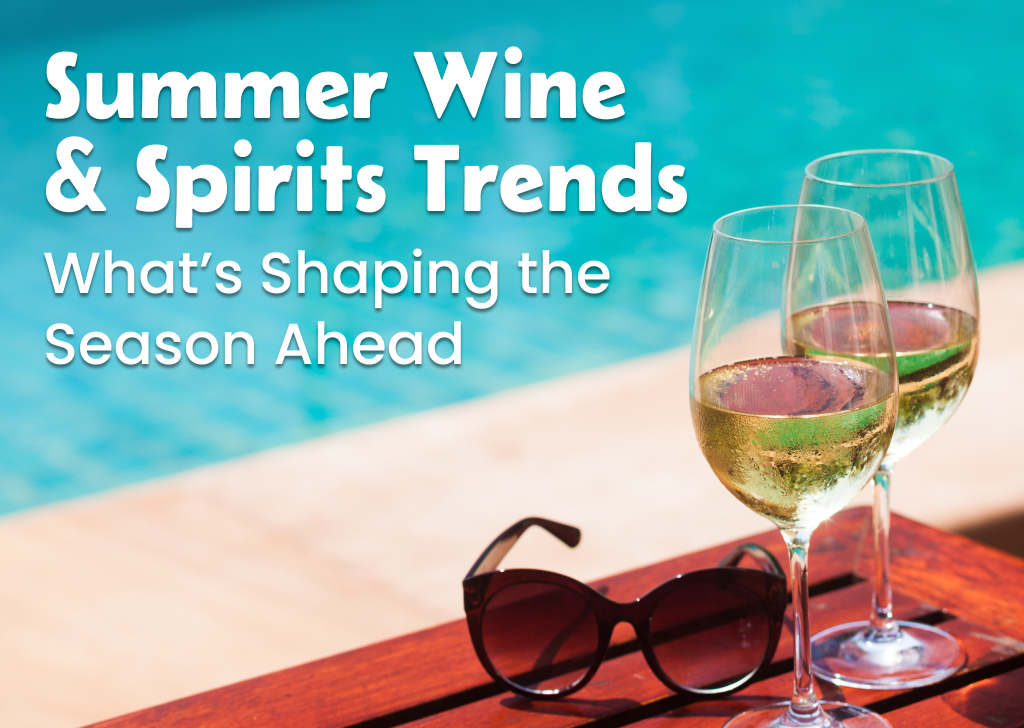As the temperatures rise and outdoor gatherings take center stage, the wine and spirits industry is buzzing with fresh ideas and consumer-driven innovation. From creative flavor profiles to sustainable practices, summer trends are poised to elevate how we sip, savor, and celebrate. Here’s a look at what’s shaping the future of summer beverages and how retailers can stay ahead of the curve.
1. Sustainability Goes Mainstream
Sustainability is no longer just a value-add—it’s becoming a non-negotiable for brands and consumers alike. This summer, expect an even greater emphasis on eco-friendly practices, from production to packaging. Lightweight bottles, biodegradable materials, and refillable options are taking over shelves, offering a more sustainable way to enjoy wines and spirits.
Producers are also leaning into regenerative farming, focusing on improving soil health and reducing water use. For example, vineyards using cover crops to increase biodiversity and distilleries repurposing waste byproducts into energy or materials are leading the charge. Shoppers are increasingly drawn to these stories, so retailers can highlight sustainable brands with dedicated displays and storytelling that connect the consumer to the product’s environmental impact.
2. Elevated Ready-to-Drink Options
Ready-to-drink (RTD) cocktails and canned wines have been summer staples for years, but they’re becoming more sophisticated with premium ingredients and creative flavor combinations. Today’s consumers want convenience without sacrificing quality, and producers are answering the call with thoughtfully crafted RTDs that rival mixologist-level creations.
Expect to see botanical-forward cocktails, such as elderflower spritzes or herbal gin fizzes, that bring a garden-fresh feel to canned options. Similarly, canned wines are venturing beyond rosé to include lesser-known varietals like albariño or Grüner Veltliner, offering a refreshing twist for adventurous palates. Retailers can highlight these premium RTDs in eye-catching displays that emphasize their portability and high-end appeal.
3. Low- and No-Alcohol Beverages Stay Strong
The low- and no-alcohol trend continues to grow as consumers prioritize health and wellness. This summer, alcohol-free wines, beers, and mocktails are becoming more refined and flavor-focused, making them just as enjoyable as their traditional counterparts.
Winemakers are crafting alcohol-free options with greater attention to complexity and mouthfeel, ensuring they deliver the same satisfaction as a traditional glass of wine. Meanwhile, spirits producers are embracing distillation techniques to create non-alcoholic alternatives that mimic the depth and character of gin, whiskey, or tequila. Offering a curated selection of these beverages can help retailers cater to a growing audience of mindful drinkers.
4. The Rise of Experiential Flavors
Bold and unexpected flavors are taking center stage this summer as consumers seek out beverages that offer more than just refreshment—they want an experience. Wines and spirits featuring unique flavor infusions, such as tropical fruits, exotic spices, or floral botanicals, are driving excitement across the market.
In wines, blends featuring unconventional varietals or experimental fermentation methods are gaining traction. For example, orange wines and pétillant-naturel (pét-nat) sparkling wines are creating buzz among younger consumers looking to explore new tastes. In the spirits world, tequila and mezcal continue to dominate, but with twists like pineapple or smoked chili infusions, offering a dynamic new take on classic summer cocktails.
5. Regional and Local Focus
As the desire for connection and authenticity grows, consumers are turning their attention to wines and spirits with strong regional identities. Supporting local producers not only reduces the carbon footprint but also celebrates the unique terroir and craftsmanship of a specific area.
This summer, expect an increase in interest in hyper-local brands that tell a story. Whether it’s a craft gin distilled using wildflowers from a nearby meadow or a wine that captures the essence of a regional microclimate, these products resonate with consumers looking to support local economies and experience something distinctive.
6. Sparkling Beverages Continue to Shine
Sparkling drinks remain a favorite for summer, but this season, they’re diversifying beyond traditional Champagne and prosecco. Natural sparkling wines, like pét-nat, are making waves for their unfiltered, slightly funky profiles that appeal to adventurous drinkers. Similarly, sparkling rosé and innovative sparkling cocktails are carving out their own niche.
Retailers can highlight these bubbly options as versatile crowd-pleasers, perfect for everything from backyard BBQs to elegant soirées. Pairing sparkling wines with seasonal recipes or cocktail suggestions can inspire customers to explore new uses for their favorite effervescent drinks.
How to Leverage These Trends
For retailers, tapping into these trends is about creating experiences that connect with customers and inspire purchases. Consider these actionable strategies:
- Curate Displays: Dedicate sections to sustainability, low-alcohol options, or local producers. Use clear signage to tell the story behind each product.
- Host Tastings or Events: If permissible, organize tastings that spotlight bold flavors, new RTDs, or unique regional offerings. Share recipes or serving tips to enhance the customer experience.
- Use Digital Campaigns: Share short videos or posts on social media that showcase seasonal pairings, cocktail ideas, or the stories behind featured brands.
This summer’s trends reflect a broader movement toward quality, sustainability, and creativity. By staying ahead of these shifts, retailers and producers can meet customer demand while setting the stage for an exciting season of exploration and celebration. Whether it’s through innovative RTDs, bold flavor profiles, or a renewed focus on eco-conscious practices, the possibilities for summer 2025 are as limitless as the season itself.
